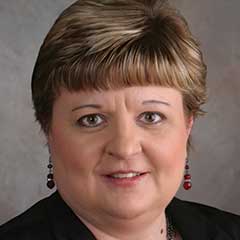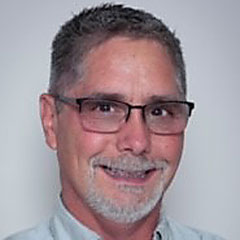Industry-Sponsored Symposia
All sessions are free and most are approved for CRCE. Attendance is limited. Pre-registered Congress attendees were invited via email to register for these symposia. However, there may still be space available. For availability and to register, check with the exhibitors that are presenting them. The AARC is not responsible for information presented at these sessions.
Display Preferences
Hide/Show

Wednesday, Nov. 18, 8:30 a.m.–10:00 a.m. Central
Online pre-registration is required
Interstitial Lung Disease: Diagnosis and Patient Management
Michael C. Zlupko, MD
Provided by Boehringer Ingelheim
Show description

Program Overview
Join Dr. Michael Zlupko as he provides an overview of common interstitial lung diseases (ILDs) and reviews the signs and symptoms of disease progression. Dr. Zlupko will also highlight the significance of comprehensive care for patients with ILD.
Learning Objectives
- Provide an overview of common ILDs and the impact of these ILDs on patients.
- Improve the identification of patients with potential ILDs in order to support a timely and accurate diagnosis.
- Develop a comprehensive care strategy for patients with ILD.
This symposia is free.
No CRCE is available for this symposia.

Wednesday, Nov. 18, 8:30 a.m.–10:00 a.m. Central
Online pre-registration is required
Patient-Ventilator Dyssynchrony
Dr. Laurent Brochard
Provided by Medtronic
Show description

Program Overview
During this event, Dr. Brochard will discuss the different mechanisms of the various patient-ventilator dyssynchronies and identify the possible impact of these dyssynchronies on patient-centered outcomes.
Learning Objectives
- Understand the different mechanisms of the various patient-ventilator dyssynchronies.
- Learn how to detect these dyssynchronies.
- Understand the possible impact of these dyssynchronies on patient-centered outcomes.
This symposia is free.
This program is approved for a maximum of 1 contact hour Continuing Respiratory Care Education (CRCE) credit by the American Association for Respiratory Care. Course #184203000.

Wednesday, Nov. 18, 3:45 p.m.–5:15 p.m. Central
Online pre-registration is required
Science and Clinical Research of APRV using the TCAV Method
Gary Nieman, BA
Nader M. Habashi, MD, FACP, FCCP
Provided by Dräger
Show description


Program Overview
Although necessary to support patients with lung injury, the ventilator itself has been shown to propagate lung injury when set incorrectly. In order to prevent this ventilator-induced lung injury (VILI), protective mechanical ventilation strategies have been advocated. Although airway pressure release ventilation (APRV) is considered a rescue ventilation mode by some clinicians, it has been advocated as a pre-emptive, protective mechanical ventilation strategy based on durable clinical experience and experimental work. It is important to note that APRV, as with all modes, can be set in a multitude of ways. It has been suggested the focus of determining the impact of ventilator strategies is primarily on macro-ventilatory parameters such as tidal volume (VT) and plateau pressure (Pplat) while overlooking the lung micro-environment. In multiple experimental, clinically applicable animal studies, the time-controlled adaptive ventilation (TCAV) method of applying APRV has demonstrated improvements in oxygenation and lung function, prevention of acute respiratory distress syndrome (ARDS) and a matching reduction in micro-anatomical injury. Experimental data demonstrate that targeting the micro-environment with TCAV improves alveolar recruitment and stability, maximizes alveolar surface area without causing overdistension and improves oxygenation while stabilizing the alveoli, reducing alveolar micro-strain and preservation of surfactant protein.
This symposium is intended for clinicians with a basic understanding of APRV and will review the science and clinical research of the TCAV method used to apply the APRV mode.
Learning Objectives
- Compare and contrast macro-parameters vs micro-environment.
- List benefits of using a ventilator strategy with emphasis on time component.
- Review experimental data covering alveolar recruitment and stability.
This symposia is free.
This course has been approved for 1.5 hours of Continuing Respiratory Care Education (CRCE) credit by the American Association for Respiratory Care. Course number: 184213000.

Friday, Nov. 20, 10:00 a.m.–11:30 a.m. Central
Online pre-registration is required
Improving Outcomes in COPD with NIV Proportional Open Ventilation from Hospital to Home
Ray Gregg, BS, CRT, RPSGT
Frederic D. Seifer, MD, FCCP
Provided by Hillrom
Show description


Program Overview
This course explores the treatment continuum for COPD, healthcare consequences, hospital readmission rates, and the role of non-invasive ventilation (NIV) including the benefits and limitations of traditional options. Open Ventilation technology technology is introduced as a new solution for providing NIV during activity in home and acute settings, including a review of the clinical data that supports its use.
Learning Objectives
- Recognize Chronic Obstructive Pulmonary Disease readmissions challenges in more advanced disease patients.
- Understand open ventilation therapy and how it facilitates activity to improve outcomes.
- Become aware of clinical data outcomes of open ventilation therapy.
This symposia is free.
This course has been approved for 1 hour of Continuing Respiratory Care Education (CRCE) credit by the American Association for Respiratory Care. CRCE Course Number: 184347000.

Friday, Nov. 20, 10:00 a.m.–11:30 a.m. Central
Online pre-registration is required
Medical Mysteries: Investigating Improved CF-ILD Care Through Patient Empowerment
Gregory P. Cosgrove, MD, FCCP
Sharon Tucker, RRT
Provided by Academy for Continued Healthcare Learning
Show description


Program Overview
The webinar will feature a pulmonologist and respiratory therapist who will explore the role of RRTs in identifying misdiagnosed or at-risk patients with Chronic-Fibrosing Interstitial Lung Disease (CF-ILD), discuss pulmonary function monitoring, and examine patient needs to maximize QoL through comprehensive care plans with the help of a Pulmonary Fibrosis Foundation (PFF) patient advocate.
Learning Objectives
- Describe the identification of chronic fibrosing interstitial lung disease (CF-ILD) across disease entities.
- Discuss the impact of CF-ILD on patient quality of life.
- Outline pharmacologic and respiratory therapy interventions that can assist patients with CF-ILD.
This symposia is free.
Continued Respiratory Care Education (CRCE) has been requested for this session through the American Association for Respiratory Care (AARC). CRCE Course Number: 184210000.

Friday, Nov. 20, 5:15 p.m.–6:45 p.m. Central
Online pre-registration is required
Clinical Application and Case Studies Applying the TCAV method of APRV
Maria Madden, MS, RRT-ACCS
Penny Andrews, RN, BSN
Provided by Dräger
Show description


Program Overview
Although Airway Pressure Release Ventilation (APRV) has been available in a mechanical ventilator since 1987, there are many clinicians that have never used the mode in clinical practice. The mode APRV was originally defined as continuous positive airway pressure (CPAP) with a brief release allowing the patient to spontaneously breathe throughout the entire respiratory cycle. The features of the prolonged CPAP duration of this mode make it ideal to recruit the lung, restore functional residual capacity (FRC) and maintain alveolar stability and lung volume while the brief duration of the release phase of the Time Low (TLow) prevents lung collapse. To date, there has been no consensus on the parameters essential to define a mechanical breath as being APRV leading to a varying description of APRV over the past three decades since it was first described. Subsequently, APRV is inconsistently applied with significant variation in the settings used in experimental studies and in clinical practice. The goal of this presentation is to review case studies and clinical application using APRV with the Time Controlled Adaptive Ventilation (TCAV) Method which is uniquely personalized to each patient. Unique to the TCAV method is the angle of the slope of the expiratory flow curve (SlopeFE) can guide personalization of setting the TLow in accordance with changes in compliance that cause tidal volume (Vt) size to adjust according to lung pathology. Case studies will show reduced compliance in an acutely injured lung accelerates the collapse time constants decreasing the SlopeFE angle <30° whereas an improvement in compliance and Vt result in a SlopeFE angle >45°. Review of clinical application of the TCAV Method will illustrate components and measurement of the SlopeFE angle including troubleshooting waveform graphics.
This symposium is intended for clinicians with a basic understanding of APRV and will review case studies and the clinical application using the TCAV method of the APRV mode.
Learning Objectives
- Identify components of the expiratory flow pattern and how to appropriately measure the slope of the expiratory flow curve.
- List factors that influence the slope of the expiatory flow curve when using the TCAV method.
- Review transition from conventional modes of ventilation to APRV using the TCAV Method.
This symposia is free.
This course has been approved for 1.5 hours of Continuing Respiratory Care Education (CRCE) credit by the American Association for Respiratory Care. Course number: 184214000.

Thursday, Dec. 3, 9:00 a.m.–10:30 a.m. Central
Online pre-registration is required
Implementation of Nasal High Flow Outside the Intensive Care Unit
Julie Jackson, RRT
Lisa Kingery, RRT, RCP
Provided by Fisher & Paykel Healthcare Inc.
Show description


Program Overview
This course describes the RT driven activities, protocols, and education involved with the comprehensive implementation of NHF across the hospital environment outside of the critical care setting.
Learning Objectives
- Describe the rationale for using Nasal High Flow (NHF) therapy across the continuum of care.
- Outline implementation strategies and factors critical for the successful adoption of NHF throughout the hospital.
- Review the educational process for successful use of Nasal High Flow outside the Intensive Care unit.
This symposia is free.
This course has been submited for Continuing Respiratory Care Education (CRCE) credit by the American Association for Respiratory Care.

Thursday, Dec. 3, 9:00 a.m.–10:30 a.m. Central
Online pre-registration is required
Providing New Technology: Oscillation and Lung Expansion (OLE) Therapy
Jeff Anderson, RRT-NPS
John Michael Prpich II, MD, FAAP
Provided by Hillrom
Show description


Program Overview
This course explores the need for airway clearance and oscillation lung expansion (OLE) therapy to address pulmonary complications in the home and acute settings. The latest advances in OLE technology is introduced including the mechanism of action and clinical data supporting its use. Finally, the presenter discusses the patients who can benefit, focusing on those with neuromuscular disorders and Cystic Fibrosis.
Learning Objectives
- Appreciate the prevalence, consequences, and cost of pulmonary complications across the continuum of care.
- Understand the mechanisms of action of Oscillation Lung Expansion (OLE).
- Identification of literature to support the use of lung expansion and secretion mobilization therapies.
This symposia is free.
This course has been approved for 1 hour of Continuing Respiratory Care Education (CRCE) credit by the American Association for Respiratory Care. Course number: 184349000.

Thursday, Dec. 3, 11:00 a.m.–12:30 p.m. Central
Online pre-registration is required
A 2020 Update: The latest Clinical Evidence for NAVA (Neurally Adjusted Ventilatory Assist) in Neonates and Adults
Dr. Howard Stein
Dr. Carlos Ferrando
Provided by Getinge
Show description


Program Overview
Neurally adjusted ventilatory assist (NAVA) promotes lung-protective synchronous ventilation in proportion to the patient's needs with higher diaphragmatic efficiency regardless of patient category or size. In our efforts to improve neonatal and adult populations’ outcomes, we will explore the latest clinical evidence utilizing electrical activity of the diaphragm (Edi) monitoring and NAVA ventilation.
Learning Objectives
- Describe the mechanics of NAVA.
- Discuss management of neonatal and adult patients on NAVA.
- Discuss the use of NIV NAVA with NAVA level 0 as a novel way to deliver CPAP.
- Review the most recent NAVIATOR study on Adult NAVA.
- Describe the physiology of Edi and NAVA ventilation.
This symposia is free.
This program has been approved for a maximum of 1.5 contact hours Continuing Respiratory Care Education (CRCE) credit by the American Association for Respiratory Care. Course number: 184223000.

Thursday, Dec. 3, 11:00 a.m.–12:30 p.m. Central
Online pre-registration is required
Personalizing Inhaled Therapy and Inhaler Choice for COPD Management
Curtis Morrison, AAS, RRT, BSHA
Matthew J. Hegewald, MD, FCCP
Provided by Boehringer Ingelheim
Show description


Program Overview
Early and accurate diagnosis of chronic obstructive pulmonary disease (COPD) followed by optimal management are very important. This educational activity will discuss the diagnosis of COPD, goals for treatment, pharmacological management, and the role of inhaled therapy and inhaler choice in the management of patients with COPD.
Learning Objectives
- Define COPD and the differential diagnosis of COPD, understanding the appropriate application of the Global Initiative for Chronic Obstructive Lung Disease (GOLD) ABCD classification tool, and tools for patient assessment.
- Recall initial pharmacological therapy, COPD management cycle, and follow-up pharmacological therapy recommendations.
- Describe the role of inhaled therapy and inhaler choice in the management of patients with COPD.
This symposia is free.
No CRCE is available for this symposia.

Saturday, Dec. 5, 7:15 a.m.–8:45 a.m. Central
Online pre-registration is required
The PRODIGY Study and the PRODIGY Risk Prediction Tool: First Step Toward Improving Outcomes and Reducing Costs
Dr. Frank Overdyk
Provided by Medtronic
Show description

Program Overview
Opioid-induced respiratory depression (OIRD) is one of the leading avoidable patient safety issues. OIRD increases morbidity & mortality as well hospital inpatient costs. This presentation will discuss the results of a recent, multi-center study (PRODIGY, a Medtronic-sponsored study), which was designed to identify people at risk for OIRD. Results showed that 46% of patients on the general care floor experienced OIRD.
Learning Objectives
- Understand the scope and harm from unrecognized respiratory depression on the med/surg floors.
- Understand the benefits and limitations of continuous respiratory surveillance monitoring on med/surg floors.
- Understand the PRODIGY trial design and results, and how to use the PRODIGY risk prediction tool.
This symposia is free.
This course has been approved for 1.5 hours of Continuing Respiratory Care Education (CRCE) credit by the American Association for Respiratory Care. CRCE Course Number: 18372300.
There are no sessions that match your display preferences.